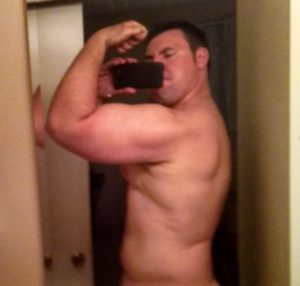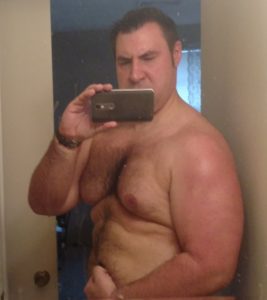On this Page I’ll Share General Thoughts, Personal Practices and Real Results That I’ve Experienced with Working Out and Fitness



General Stats (at my largest)
Height: 6’2
Weight: 285 lbs.
Biceps: 19″
Chest: 52″
Thighs: 31.5″
Calves: 20″
Neck: 19″
Forearms: 14″
Waist: 44″
Hips: 44″
Wrist: 7.75″
Legs

Traps





I have always
Work Out Philosophy:
Since I begun working out off and on at around 13 – 14 years old, I have prescribed to the philosophy of lifting until failure. That is the practice of lifting a weight until you physically are incapable of completing your last repetition. A good rule of thumb to determine if you’ve reached failure is if someone put a gun to your head, would you be able to lift a weight, with your life on the line, one more time? If you could, then you have not yet reached failure. However if you are physically incapable of completing that last rep, even if someone put a gun to your head, then you have truly reached failure.
This is not an easy state of mind or body to reach, and it takes a lot of discipline. You’re not going to always achieve this level of muscle exhaustion, but coming as close as you can on every lift is the goal. Many famous weight lifters such as Dorian Yates and Mike Mentzer prescribed to this lifting philosophy. Not everyone agrees with it, and everyone and their body is different and may respond in different ways. However, it has worked for me fairly well throughout my years of working out.
One Main Set to failure is all you need
Another not so common practice that I have always partaken in is that I only lift one main set per lift, and a lot of times only one main set per muscle group! This was another technique of Mike Mentzer’s as well, the idea being that if you lift hard and reach true failure, you have already stretched and broken down the muscle fibers about as much as they are going to be for the day. Doing multiple sets of the same weight is useless, ineffective, and counter productive. How many times have you seen, or heard, in the gym the old adage of “three sets of ten”? Well, if you can do three sets of ten, then you are not lifting enough weight on your first set, nor are you close to reaching failure on that set. Better to lift and reach total failure on your main set the first time, to fully work the muscle, rather than to partially work it multiple times in a row.
Now, this doesn’t include drop sets, which I do partake in to make sure that I have fully worked all aspects of the muscle. However, I never lift more than one main set for any lift, and I always try to reach failure when lifting, or come close to it. There are a few exceptions to this, it is hard, for instance, to target the entire chest with just one lift. So for chest, I do flat chest press, inclined press, and cable flies to make sure I fully work the muscle, but I only do one set to failure for each of those lifts. Legs and arms incorporate multiple muscles (pulling, and pushing) so you want to make sure you isolate and work each of those, but I only do one set to failure for each. IE, one set each of leg extensions, leg curls, calf raises, etc. I also do compound lifts like the leg press that will also work your auxiliary muscles, though it doesn’t isolate and target them specifically, which is why I do so later.
It’s very important to structure your workout so that the larger more compound lifts are done first before the more isolating lifts. IE, a bench or dumb bell chest press incorporates many auxiliary muscles into the lift aside from just your chest (like triceps, etc). If you work your triceps first, your going to severely hinder your performance on a larger compound lift that also utilizes those as auxiliary / stabilizing muscles. Same thing with a squat or leg press, you are using all of the muscles in your legs, plus your gluts to achieve the larger lift. If you isolate those muscles first with workouts, like doing calf raises or leg extensions first, you’re main compound lifts are going to be shot!
My Workout Schedule
Because I am only working most muscle groups out with one set to failure, I am not blocking off entire days where I target just one muscle group for one workout a week (like only doing chest once on Monday, arms once on Tuesday, etc.). Instead, I am working out multiple complimentary and related muscle groups each workout, and I do each work out twice a week. Basically, I split up my body into two halfs / work outs, which I do twice a week.
Workout A: I do Legs, Back, Traps, Biceps, Forearms
Workout B: Consists of Chest, Shoulders, Lats, Triceps, and Abdominals
My workout schedule for the week would look like:
Monday: Workout A
Tuesday: Workout B
Wednesday: Rest (can do cardio)
Thursday: Workout A
Friday: Workout B
Weekends: Rest (can do cardio)
Depending on your body, you need at least 48 hours of rest after fully working a muscle to failure and tearing down the fibers. You never want to workout a muscle two days in a row, you won’t have sufficient time for it to recover, and you’ll just keep breaking down your muscle fibers and overwork and destroy the muscle. Now this schedule is what I do and what works for me, I find that I can recover enough generally to workout each muscle group twice a week. However, everyone is different, and if you don’t feel like you’re recovering fast enough, it means your body needs more time and once a week, or week and a half, is fine. There are times that I don’t workout for a month or more at a time, and when I first get back into lifting, I need more recovery time and can only lift a muscle group once in a week.
Working Out in Cycles
Muscles are stimulated for growth through stress and shock. If a muscle gets used to a particular routine, it will adapt to the stress and growth will stagnate. Therefore, in order to help keep the muscle under shock and avoid complacency, it’s good to switch things up in the gym. A lot of people like to swap different types of lifts to help achieve this, for instance, if they were doing dumbbell curls for biceps, they’ll then switch to barbell curls. What I like to do is switch lifting routines entirely and partake in different rotating lifting “cycles”. The “cycles” are lifting routines that vary the amount of weight and number of repetitions in a lift to tailor the set to target a muscle for either mass (maximum growth), endurance, or strength. This is another somewhat controversial school of thought, but there is a hypothesis that the amount of times you are able to lift a weight until failure will determine how the muscle will react to that stress. IE, will it grow larger, stronger, or obtain more endurance, through the type of lifting that you’re doing?
The idea is that the muscle is optimized for growth if you tailor your set so that you reach failure between 8 – 12 repetitions, which I refer to as the “mass cycle”. To reach failure between 8 – 12 reps, you’ll be lifting around 80% of your hypothetical one rep max lift. So if you have a one rep max on the bench press of say 300 lbs, then 80% of that one rep max would be around 240 lbs. which should put you in the 8 – 12 rep range till failure for your mass cycle. I say hypothetical one rep max, because in general trying to find and achieve a “one rep maximum lift” is dangerous and should generally not be attempted, or attempted rarely. It is easier to work backwards to find your one rep max (how many times you can lift a given weight to failure will equate roughly to a percentage for how much you could lift a given weight one time) than to attempt to try it on your own and risk injuring yourself.
What the rep range means is that if you are incapable of lifting the minimum number of reps in the range, then the weight you are using is too heavy and needs to be lowered. Conversely, if you can do more reps than the highest number in the range, then the weight is too light, and you need to move the weight up. So for mass, you want to be able to lift a given weight till failure for as least 8 reps. Over time, as you get stronger, you’ll eventually get to a point where you’ll be able to lift more than 12 reps, at that point you’ll move the weight up slightly for next time. This method will ensure slow but steady and consistent gains in strength and muscle mass over time.
It generally takes at least three weeks for your body to start to adjust to a certain lifting cycle or routine and start making progress. Therefore, you shouldn’t do a cycle for any less of a period of time than one month. I typically stick with a cycle for around 2 – 3 months before I start to really stagnate and switch to the next cycle. The next cycle after mass is the endurance cycle. This is when you lift a lighter weight for high repetitions which will train your muscle for endurance. Your target rep range will be between 18 – 28 reps. If you can’t do 18, you’re weight is too heavy. If you can do more than 28 reps before reaching failure, then the weight is too light.
I keep a fast and steady pace when lifting for the endurance cycle. A controlled speed, not recklessly fast, where you’ll have the weight bouncing and working off it’s own momentum. When working out out with this cycle, since you are doing so many repetitions and really taxing the muscle, I do not do any additional drop sets. This is also a cycle I default to if I am injured / recovering from an injury as it is the least taxing on the body and less likely to re/further injure yourself with the lighter weights.
Now, that we’ve address the mass and endurance cycle, let’s talk about the strength , or power, cycle. I’ve listed these cycles in a certain order for a reason, in order to properly lift for strength, you need to first develop the muscle mass and muscle endurance needed. Ideally for strength, you would lift the max weight your body is capable of lifting for a given exercise, one time. However, as previously discussed, this is tricky and hazardous to find and perform. Therefor, a safer way to target strength is to lift a weight to failure between 2 – 5 times. This will equate to roughly 90% of your hypothetical one rep max. Using propery strict form is important so as to keep from injury. As before, if you are unable to lift a weight twice, you want to lower the weight a bit. If you can do 6 or more reps, you want to move the weight up.
Even if you don’t prescribe to the idea that different weight cycles work the muscle in different ways, the mere fact of switching up the weight and repetitions in your lift will shock the muscles and keep them from stagnating with the same old routine.
Nutrition / Supplements
I have never been too sophisticated or strict about nutrition or supplements. I’ve never been a fan of drugs of any kind, and for some reason I viewed even taking supplements, like protein powder, as “cheating”. This wouldn’t have been so bad if I had eaten enough real food protein throughout the day to properly feed my muscle growth, but I wasn’t doing that either. Not only did I not take any supplements of any kind (not even protein powder) but I wasn’t eating enough real food protein throughout the day to properly fuel my muscle growth. In fact, I neglected this to the point where I was actually hampering my progress by not providing my body with the necessary nutrition it needed to fully grow to its full potential. It wasn’t until around 2015 that I finally got on a schedule of nutrition that properly fed my muscles, and the change and growth I saw was immediate!
I was always large, but I gained about 15 pounds of muscle right off the bat just by altering my nutrition and supplement intake (later increasing to 25 lbs.). I begun by purchasing my first protein powder, “Carnivore”, because I really liked the idea of an actual beef protein powder. I view beef protein as being one of the best for muscle growth, and the “Carnivore” powder had that in a convenient powder form. In addition it had creatine, which I’m sure also helped contribute to my sudden gains, and amino acids.
Before, I would skip breakfast, have a late lunch, and not much else throughout the day until I had a very late dinner after my evening workout. Now I always liked to have a large dinner and I would FEAST, but the body went too far between protein intakes to properly feed the muscle growth. Now, I make sure I have a quality protein powder shake in the morning, a moderate lunch with protein, another protein shake in the afternoon, and then the same large dinner feast after my evening workout. Just doing this was enough to make a large difference in my muscle growth.
For food, I generally eat whatever I like, but I try to keep it high in animal protein, and I try to limit my carb and junk intake. I love pasta, bread, pizza, etc. And I will fully indulge in large portions of such when I do eat them, but I make sure to not eat those foods often. You’ve heard of a sweet tooth, well, I have a meat tooth, and meat is my real passion with food. As such I generally like to eat steaks, fish, chicken, etc. As long as I am eating meat, I am generally happy, so it is not too difficult for me to avoid the carbs, sweets and bad stuff. I do not shy away from fatty meats either, as I am a firm believer in the health and nutritional benefits of animal fats and cholesterol (hormones like testosterone are produced from cholesterol, and your brain is primarily composed of cholesterol).
